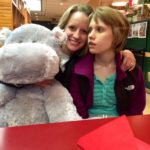GAN Gene Therapy Trial Gets Green Light

Last Friday, February 13th, Lori Sames couldn’t stop crying as she stared at her screen in a coffee shop near her home in Rexford, New York. The announcement had just gone up at clinicaltrials.gov: NCT02362438: Intrathecal Administration of scAAV9/JeT-GAN for the Treatment of Giant Axonal Neuropathy.
Finally.
Translation: recruitment for participants could begin for a clinical trial to test whether genes could be safely transferred into the spinal cord to treat, or at least arrest, a rare neurological disease, giant axonal neuropathy, or GAN. Lori’s 10-year-old Hannah has the disease, and if it weren’t for the family’s efforts, the clinical trial set to begin could still be many years away.
Lori and her husband Matt have raised more than $6 million to get the GAN clinical trial going, in a race against time to save their daughter Hannah and the other 70 or so kids and young people in the world with the disease. Early on they had selected gene therapy as the way to go.
 Hannah’s Hope Fund was born in Lori and Matt’s home, shortly after the adorable kinky-haired little girl was diagnosed on March 24, 2008. She had just turned four. I’ve chronicled their journey at DNA Science, here and here, as well as in my book The Forever Fix: Gene Therapy and the Boy Who Saved It. Lori came up with “forever fix” during our first conversation years ago.
Hannah’s Hope Fund was born in Lori and Matt’s home, shortly after the adorable kinky-haired little girl was diagnosed on March 24, 2008. She had just turned four. I’ve chronicled their journey at DNA Science, here and here, as well as in my book The Forever Fix: Gene Therapy and the Boy Who Saved It. Lori came up with “forever fix” during our first conversation years ago.
GAN is like ALS in a child. But people aren’t lining up to pour ice over each other’s heads to raise funds, for if ALS is a zebra amongst the horses that are common diseases, then GAN is a unicorn. The clinical trial announcement provides a good description:
“The gigaxonin gene lets the body make a protein, gigaxonin, that nerves need to work. Giant axonal neuropathy (GAN) causes a shortage of functional gigaxonin. Nerves stop working normally. This causes problems with walking and sometimes with eating, breathing, and many other activities. GAN has no cure. GAN can shorten life. Researchers want to see if a gene transfer treatment may help people with GAN.”
 Hannah needs a wheelchair now, but she’s still very much Hannah. She beautifully sang the national anthem at several local hockey games in recent weeks.
Hannah needs a wheelchair now, but she’s still very much Hannah. She beautifully sang the national anthem at several local hockey games in recent weeks.
In an ironic and cruel twist, Hannah won’t be among the first to receive the gene therapy. She has a double deletion mutation, one copy inherited from each parent, and so her body doesn’t make gigaxonin at all, not even an altered version of it. And so introducing healthy gigaxonin into her body could trigger an overwhelming immune response.
In the rare disease community, a triumph for one is a triumph for all. So this week before Rare Disease Day, I’d like to share a few comments about what Hannah’s Hope has accomplished.
From clinical trial director Steven Gray, PhD, from the University of North Carolina School of Medicine, at the annual Hope and Love ball for Hannah’s Hope, February 7:
“None of this work would have occurred without the people in this room, and the entire Hannah’s Hope community… While we have come a long way, we have a long way to go. Hannah, and patients like her, who are unique in that they make no detectable protein, cannot participate in the Phase 1 trial. Studies are underway to try options for preventing her immune system from interfering with gene delivery. Also, as we learn more, we have more populations of cells we know we need to target in GAN patients beyond this initial delivery to the central nervous system.”
From Lori Sames, announcing the start of the trial:
“We will know in late April which immune tolerance protocol Hannah will receive, and we want you all with us, every step of the way. We believe in the power of positive thinking and ask that you focus your positive thoughts and prayers on those children who will soon be receiving gene delivery and on Hannah when she is injected, hopefully before the end of the summer.”
A web of shared experience, support, and hope closely connects the rare disease community. Laura King Edwards’ sister Taylor, 16, is battling Batten disease. Laura blogs at Write the Happy Ending and is writing a memoir about Taylor’s fight (it’s great, I’m an early reader). She blogged recently about the link between Hannah and Taylor:
“Nearly five years ago, when my sister could still sing and talk and walk and eat ice cream cones on hot summer days, my mother [Sharon King] met Steve Gray, a young investigator from the University of North Carolina Gene Therapy Center, at a conference in Bethesda. Since 2008 he’d been working on GAN, an ultra-rare, fatal childhood disease that causes progressive nerve death.

Months later, we drove to Chapel Hill to have dinner with him near his lab. We weren’t ready to take the leap then, but Mom had believed in Steve since the first time she heard him speak about his effort to save children from a monster that turned them into quadriplegics unable to eat or breathe on their own. When I sat across from Steve at our booth in a Franklin Street restaurant that day, I believed in him, too.
Our only mistake was that we didn’t fund Steve more quickly; it took Taylor’s Tale three years to sign on as co-funders of a project modeled after the GAN work, announced on World Rare Disease Day in February 2013. In doing so we followed in the footsteps of Hannah’s Hope Fund. Like my mother, Lori Sames entered the fight against GAN with no medical background. But Lori traveled the world, speaking to PhDs and MDs and biotech executives and raising millions of dollars in hopes of saving Hannah and kids like her.
Clinical trials happen all the time. But this one, for a little-known yet devastating disease that affects fewer than 100 children in the world, would never have happened without the dogged determination of Hannah’s family, who raised $6.5 million from their kitchen in upstate New York. It wouldn’t have happened without the genius and iron will of Steve Gray, who took an idea and turned it into a treatment in 6.5 years. This is light speed in the world of science, particularly for an ultra-rare disease like GAN.

I won’t forget the night Lori Sames flew to Charlotte to speak to the Taylor’s Tale board, or the day I took a long lunch to watch the webcast of my mother speaking on behalf of Hannah’s Hope Fund at the National Institutes of Health. That day, the Recombinant DNA Advisory Committee (RAC) granted approval for the GAN trial preparations to continue – a vital step in ensuring a better future for children with GAN.
I don’t think a rare disease has ever met a tougher match than Lori Sames or my mom. Lori and my mom looked their child’s rare disease in the face and said, “You will NOT defeat me. I will NOT sit back and let you take my child without a fight.” And because of the choices they’ve made, there is a light at the end of their respective tunnels.
We’ve poured everything into finding a treatment for infantile Batten disease since Taylor was diagnosed in 2006. I know Taylor’s Tale is a big reason why we are far closer to an answer today than we were then. But Taylor’s light is fading, and I’ve had to come to terms with the fact that the work we’re doing is for future Taylors.

So today, I try to focus on the good moments I’m able to steal with my sister. She can’t talk to me any longer, but sometimes I can make her laugh.
Hannah and Taylor are in the researchers’ minds when they’re in the lab, and I think that’s part of what drives them to be so good at what they do. I’ll never forget the first time I visited Steve’s lab at UNC. Photos of sick children decorate his office door. He told me that seeing the faces of those kids motivates him.
And though I understand now that we’re probably too late to save my sister, I still believe in this: that one day soon, because people like Steve Gray were motivated by the faces of kids on their office doors, kids like Hannah and Taylor won’t die young.”

Thank you for sharing our story, Ricki! Hannah, her family, the Hannah’s Hope team and Steve Gray are all an inspiration!